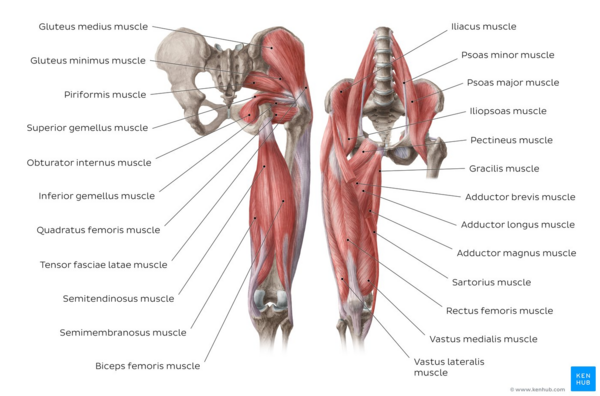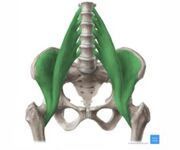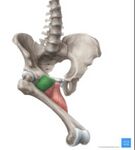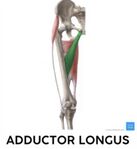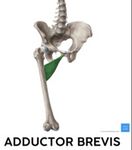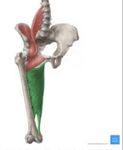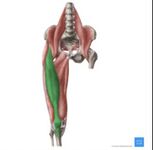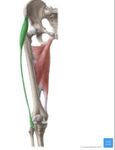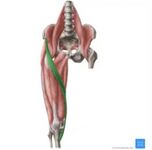Thomas Test: Difference between revisions
Tony Varela (talk | contribs) m (added project template) |
No edit summary |
||
| Line 9: | Line 9: | ||
== Purpose == | == Purpose == | ||
[[File:Muscles of the hip and thigh - Kenhub.png|alt=Overview of the hip and thigh - anterior and posterior views|right|frameless|600x600px|Overview of the hip and thigh - anterior and posterior views]] | [[File:Muscles of the hip and thigh - Kenhub.png|alt=Overview of the hip and thigh - anterior and posterior views|right|frameless|600x600px|Overview of the hip and thigh - anterior and posterior views]] | ||
The Thomas Test | The Thomas Test measures hip flexor length and distinguishes tightness between one joint and two joint muscles.<ref name=":1">Kendall F, McCreary E, Provance P. Muscles: Testing and Function with Posture and Pain. 4th ed. Baltimore: Lippincott, Williams & Wilkins; 1993.</ref> | ||
# Impaired range of motion of the hip may be an underlying cause to other conditions such as: psoas syndrome; [[Patellofemoral Pain Syndrome|patellofemoral pain syndrome]] | # Impaired range of motion of the hip may be an underlying cause to other conditions such as: psoas syndrome; [[Patellofemoral Pain Syndrome|patellofemoral pain syndrome]]; [[Low Back Pain|lower back pain]], [[osteoarthritis]]; [[Rheumatoid Arthritis|rheumatoid arthritis]]. | ||
# Often associated with runners, dancers, and gymnasts who complain of hip "stiffness" and reported "snapping" feeling when flexing at the waist. | # Often associated with runners, dancers, and gymnasts who complain of hip "stiffness" and reported "snapping" feeling when flexing at the waist. | ||
Image: Overview of the hip and thigh - anterior and posterior views<ref >Overview of the hip and thigh - anterior and posterior views image - © Kenhub https://www.kenhub.com/en/library/anatomy/hip-and-thigh-anatomy</ref> | Image: Overview of the hip and thigh - anterior and posterior views<ref >Overview of the hip and thigh - anterior and posterior views image - © Kenhub https://www.kenhub.com/en/library/anatomy/hip-and-thigh-anatomy</ref> | ||
== Relevant Anatomy == | == Relevant Anatomy == | ||
There are various muscles making up the hip flexor group being tested in the Thomas Test: | |||
{| class="wikitable" | |||
|Hip Flexor Muscle | |||
|Picture | |||
(Muscle in green) | |||
|Number of Joints Crossed | |||
|Main Function | |||
|Additional Movement | |||
|- | |||
|Iliopsoas: Composed of iliacus and psoas major | |||
|[[File:Iliopsoas Muscle.jpg|center|thumb|180x180px]] | |||
|One joint: Hip | |||
|Hip flexion | |||
|Hip external rotation | |||
|- | |||
|Pectineus | |||
|[[File:Pectineus Muscle.jpg|center|thumb|150x150px]] | |||
|One joint: hip | |||
|Hip flexion | |||
|Hip abduction | |||
|- | |- | ||
| | |Adductor Longus & Brevis | ||
| | |[[File:Adductor Longus Muscle.jpg|center|thumb|150x150px]][[File:Adductor Brevis Muscle.jpg|center|thumb|150x150px]] | ||
| | |One joint: hip | ||
|Hip adduction | |||
|Hip flexion and external rotation | |||
|- | |- | ||
| | |Adductor Magnus | ||
| Hip flexion | |[[File:Adductor Magnus Muscle.jpg|center|thumb|150x150px]] | ||
| | |One joint: hip | ||
|Adductor part: Hip flexion, adduction, external rotation | |||
|Hamstring part: Hip extension and internal rotation. | |||
|- | |- | ||
| Rectus femoris | |Rectus femoris | ||
| Hip flexion | |[[File:Rectus Femoris Muscle.jpg|center|thumb|153x153px]] | ||
| Knee extension | |Two joints: Hip and knee | ||
|Hip flexion | |||
|Knee extension | |||
|- | |- | ||
| [[Tensor Fascia Lata| | |Tensor fascia lata | ||
| Hip flexion | |[[File:Tensor Fascia Lata.jpg|center|thumb|150x150px]] | ||
| | |Two joints: Hip and knee | ||
|Hip abduction, flexion, internal rotation | |||
|Knee extension | |||
|- | |- | ||
| Sartorius | |Sartorius | ||
| Hip flexion | |[[File:Sartorius Muscle.jpg|center|thumb|152x152px]] | ||
| Knee flexion | |Two joints: Hip and knee | ||
|Hip flexion, abduction, external rotation | |||
|Knee flexion | |||
|} | |} | ||
"The copyright holder has given special permission to use these images in Physiopedia" | |||
This 16 minute video is a good summary of the lower extremity muscles. | |||
How to Remember Every Muscle of the Lower Limb and Leg | [https://youtu.be/mlnq-HjWRbA Corporis]<ref name=":1" /> | |||
{{#ev:youtube|mlnq-HjWRbA&ab_channel=Corporis}} | |||
== Technique == | == Technique == | ||
| Line 51: | Line 80: | ||
* Patient is supine ,with lower gluteal folds at the end of the table and their hips and knees flexed. (Patient may hold the legs in flexion with their hands). | * Patient is supine ,with lower gluteal folds at the end of the table and their hips and knees flexed. (Patient may hold the legs in flexion with their hands). | ||
* Therapist makes sure that the patient’s lower back is in a neutral pelvic tilt. | * Therapist makes sure that the patient’s lower back is in a neutral pelvic tilt. | ||
* Patient keeps the unaffected leg flexed, and slowly lowers the affected leg and lets it extend as far as it can.<ref name=":0" /> | * Patient keeps the unaffected leg flexed, and slowly lowers the affected leg and lets it extend as far as it can.<ref name=":0">Special tests Thomas Test Available:https://special-tests.com/hip-pelvis-tests/thomas-test/ (accessed 18.1.2022)</ref> | ||
== Interpretation == | == Interpretation == | ||
Revision as of 21:20, 5 April 2023
<div class="noeditbox">Welcome to [[Arkansas Colleges of Health Education School of Physical Therapy Musculoskeletal 1 Project]]. This space was created by and for the students at Arkansas Colleges of Health Education School in the United States. Please do not edit unless you are involved in this project, but please come back in the near future to check out new information!!</div>
Original Editor - Tyler Shultz
Top Contributors - Aurelie Canas Perez, Maddison Jones, Ashtyn Madden, Admin, Kim Jackson, Magdalena Hytros, Shelby Morrison, Joao Costa, Rachael Lowe, Lucinda hampton, Tyler Shultz, Johnathan Fahrner, Yvonne Yap, Kevin Campion, Tony Varela, Matt Huey, Kai A. Sigel, Leana Louw, Sue Safadi, Oyemi Sillo, Naomi O'Reilly, Adam Vallely Farrell and Wanda van Niekerk
<div class="noeditbox">Welcome to [[Arkansas Colleges of Health Education School of Physical Therapy Musculoskeletal 1 Project]]. This space was created by and for the students at Arkansas Colleges of Health Education School in the United States. Please do not edit unless you are involved in this project, but please come back in the near future to check out new information!!</div>
Purpose[edit | edit source]
The Thomas Test measures hip flexor length and distinguishes tightness between one joint and two joint muscles.[1]
- Impaired range of motion of the hip may be an underlying cause to other conditions such as: psoas syndrome; patellofemoral pain syndrome; lower back pain, osteoarthritis; rheumatoid arthritis.
- Often associated with runners, dancers, and gymnasts who complain of hip "stiffness" and reported "snapping" feeling when flexing at the waist.
Image: Overview of the hip and thigh - anterior and posterior views[2]
Relevant Anatomy[edit | edit source]
There are various muscles making up the hip flexor group being tested in the Thomas Test:
| Hip Flexor Muscle | Picture
(Muscle in green) |
Number of Joints Crossed | Main Function | Additional Movement |
| Iliopsoas: Composed of iliacus and psoas major | One joint: Hip | Hip flexion | Hip external rotation | |
| Pectineus | One joint: hip | Hip flexion | Hip abduction | |
| Adductor Longus & Brevis | One joint: hip | Hip adduction | Hip flexion and external rotation | |
| Adductor Magnus | One joint: hip | Adductor part: Hip flexion, adduction, external rotation | Hamstring part: Hip extension and internal rotation. | |
| Rectus femoris | Two joints: Hip and knee | Hip flexion | Knee extension | |
| Tensor fascia lata | Two joints: Hip and knee | Hip abduction, flexion, internal rotation | Knee extension | |
| Sartorius | Two joints: Hip and knee | Hip flexion, abduction, external rotation | Knee flexion |
"The copyright holder has given special permission to use these images in Physiopedia"
This 16 minute video is a good summary of the lower extremity muscles.
How to Remember Every Muscle of the Lower Limb and Leg | Corporis[1]
Technique[edit | edit source]
- Patient is supine ,with lower gluteal folds at the end of the table and their hips and knees flexed. (Patient may hold the legs in flexion with their hands).
- Therapist makes sure that the patient’s lower back is in a neutral pelvic tilt.
- Patient keeps the unaffected leg flexed, and slowly lowers the affected leg and lets it extend as far as it can.[3]
Interpretation[edit | edit source]
Thomas test: The following structures may be considered during a positive test.[4]
| Sign | Structures affected |
|---|---|
| Extended knee | Quadriceps, rectus femoris |
| Flexed hip | Psoas muscles |
| Abducted hip | Tensor fascia lata, iliotibial band |
| Tibia lateral rotation | Biceps femoris |
A modified version of the test is one in which the patient lies down on their back, at the very edge of the table, with both legs hanging freely. The patient must then flex their knee and pull it back to their chest as close as they can, using both arms while doing so. The other leg can hang The lumbar spine must remain flat and in contact with the table during the test. The second video below shows technique.
Viewing[edit | edit source]
An easy test to perform, as shown in this 40 second video.
Thomas Test video provided by Clinically Relevant
This 40 second video shows the modified test.
Reliability[edit | edit source]
Studies that test the reliability of the Thomas study are very limited.
- One study has demonstrated that the modified Thomas test has a very good inter-rater reliability.[6] Another has demonstrated that the modified Thomas test, has an average of only moderate levels of reliability.[7] Further research is required to prove or to refute the reliability of the Thomas test.
- Peeler & Anderson conducted a study in 2006 examining the reliability of the Thomas test for assessing hip range. Their study calls into question the reliability of the technique when used to score range of motion and iliopsoas muscle flexibility about the hip joint using both goniometer and pass/fail scoring methods.[8]
Resources[edit | edit source]
This 17 minute video is a good summary of the muscles of the hip and thigh.[9]
References[edit | edit source]
- ↑ 1.0 1.1 Kendall F, McCreary E, Provance P. Muscles: Testing and Function with Posture and Pain. 4th ed. Baltimore: Lippincott, Williams & Wilkins; 1993.
- ↑ Overview of the hip and thigh - anterior and posterior views image - © Kenhub https://www.kenhub.com/en/library/anatomy/hip-and-thigh-anatomy
- ↑ Special tests Thomas Test Available:https://special-tests.com/hip-pelvis-tests/thomas-test/ (accessed 18.1.2022)
- ↑ Medical Dictionary Thomas Test Available:https://medical-dictionary.thefreedictionary.com/Thomas+test (accessed 18.1.2022)
- ↑ Liverpool Chiropractic & Sports Injury Clinic. Hip Mobility Assessment | Modified Thomas Test. Available from https://www.youtube.com/watch?v=9fdHMryWbpI (accessed 28/11/2020).
- ↑ Gabbe BJ, Bennell KL, Wajswelner H, Finch CF. Reliability of common lower extremity musculoskeletal screening tests. Physical Therapy in Sport 2004;5(2):90-7.
- ↑ Clapis PA, Davis SM, Davis RO. Reliability of inclinometer and goniometric measurements of hip extension flexibility using the modified Thomas test. Physiotherapy theory and practice 2008;24(2):135-41.
- ↑ Peeler J, Anderson JE. Reliability of the Thomas test for assessing range of motion about the hip. Physical Therapy in Sport. 2007;8(1):14-21.
- ↑ Muscles of the hip and thigh video - © Kenhub https://www.kenhub.com/en/library/anatomy/hip-and-thigh-anatomy
